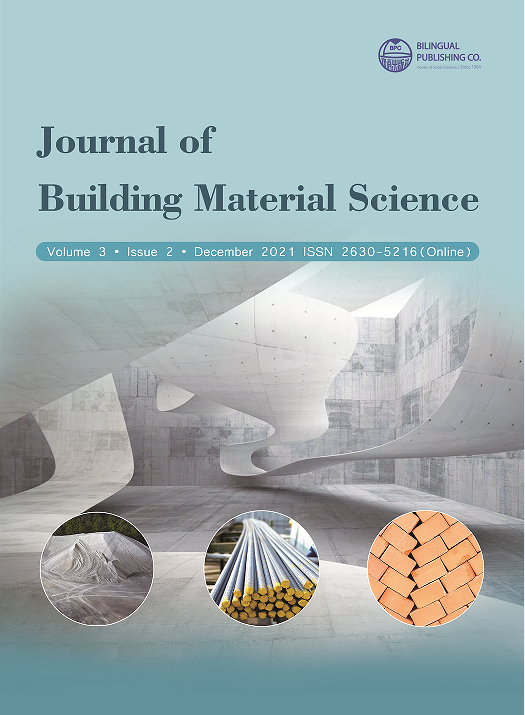
Effects of the Addition of Sawdust Ash and Iron Ore Tailings on the Characteristics of Clay Soil
DOI:
https://doi.org/10.30564/jbms.v3i2.3732Abstract
An evaluation of the effects of additives and firing temperatures on clay bricks characteristics was studied. The two (2) additives used were sawdust ash (SDA) and iron ore tailing wastes (IOTW), and the five (5) firing temperatures of 400o C to 1200o C at intervals of 200o C were applied. The fired bricks were tested for linear shrinkage, water absorption, density, and compressive strength. The results of the investigations showed that firing temperature improved the clay brick characteristics across all replacement levels. However, the SDA additions increased the linear shrinkage and the water absorption but decreased the density and compressive strength. On the other hand, the addition of IOTW to the clay-SDA mixture, reduced both the linear shrinkage and water absorption of the clay bricks, and increased the density and compressive strength. The statistical values and the regression models derived on the experimental data using Minitab 18 Software were significant.Keywords:
Additives; Firing temperature; Clay bricks; Bricks characteristics; Statistics; Regression modelsReferences
[1] M Sutau, H Alptckin, E Erdogmus, Y Er, O Gencel (2015). “Characteristics of fired clay bricks with waste marble power addition as building materials,” Construction and Building Materials, 82, 1-8.
[2] S Janbuala and T Wasanapiarnpong (2016). “Lightweight clay brick ceramic prepared with bagasse addition.” ARPN Journal of Engineering and Applied Sciences, 11 (13), 8380-8384.
[3] Aouba, Laila and Bories, Cécile and Coutand, Marie and Perrin, Bernard and Lemercier, Hervé Properties of fired clay bricks with incorporated biomasses: Cases of Olive Stone Flour and Wheat Straw residues. (2016) Construction and Building Materials, 102 (Part. 1). 7-13. ISSN 0950-0618.
[4] AA Kadir, NA Sarani, MMAB Abdullahi, MC Perju, AV Sandu (2017). “Study on fired clay bricks by replacing clay with palm oil waste: Effects on physical and mechanical properties,” International Conference on Innovative Research – ICIR EUROINVENT IOP Conf. Series: Materials Science and Engineering 209, 012037. DOI: https://doi.org/10.1088/1757–899x/209/1/01037.
[5] Srisuwan A, Sompech S, Saengthong C, Thaomola S, Chindraprasirt P, and Phonphuak N (2020). “Preparation and properties of fired clay bricks with added wood ash.” Journal of Metals, Materials and Minerals, 30, (4), 84-89.
[6] Elinwa AU (2006). “Effect of addition of sawdust ash to clay bricks.” Civil Engineering and Environment Systems, 23 (4), 263-270.
[7] ASTM C210-95 (2019). Standard Test Method for Reheat Change of Insulating Firebrick.
[8] ASTM C 373-88 (2006). Standard Test Method for Water Absorption, Bulk Density, Apparent Porosity, and Apparent Specific Gravity of Fired Whiteware Products.
[9] ASTM C216-19 (2019). Standard Specification for Building Brick (Solid Masonry Units Made from Clay or Shale).
[10] BS 1377-4:1990. Methods of Test for Soils for Civil Engineering Purposes. Compaction-Related Tests – BSI British Standards.
[11] E. K. Arthur & E. Gikunoo | (2020) Property analysis of thermal insulating materials made from Ghanaian anthill clay deposits. Cogent Engineering, 7:1, 1827493.DOI: https://doi.org/10.1080/23311916.2020.1827493.
[12] G Cultrone, E Sebastian, MJ de la Torre (2005). “Mineralogy and physical behavior of solid bricks with additives.” Construction and Building Materials, 19, 39-48.
Downloads
How to Cite
Issue
Article Type
License
Copyright © 2021 Elinwa Augustine Uchechukwu, Mohammed Abdulrahaman Shehu, Mohammed Ahmed Bafeto

This is an open access article under the Creative Commons Attribution-NonCommercial 4.0 International (CC BY-NC 4.0) License.







 Elinwa, Augustine Uchechukwu
Elinwa, Augustine Uchechukwu





